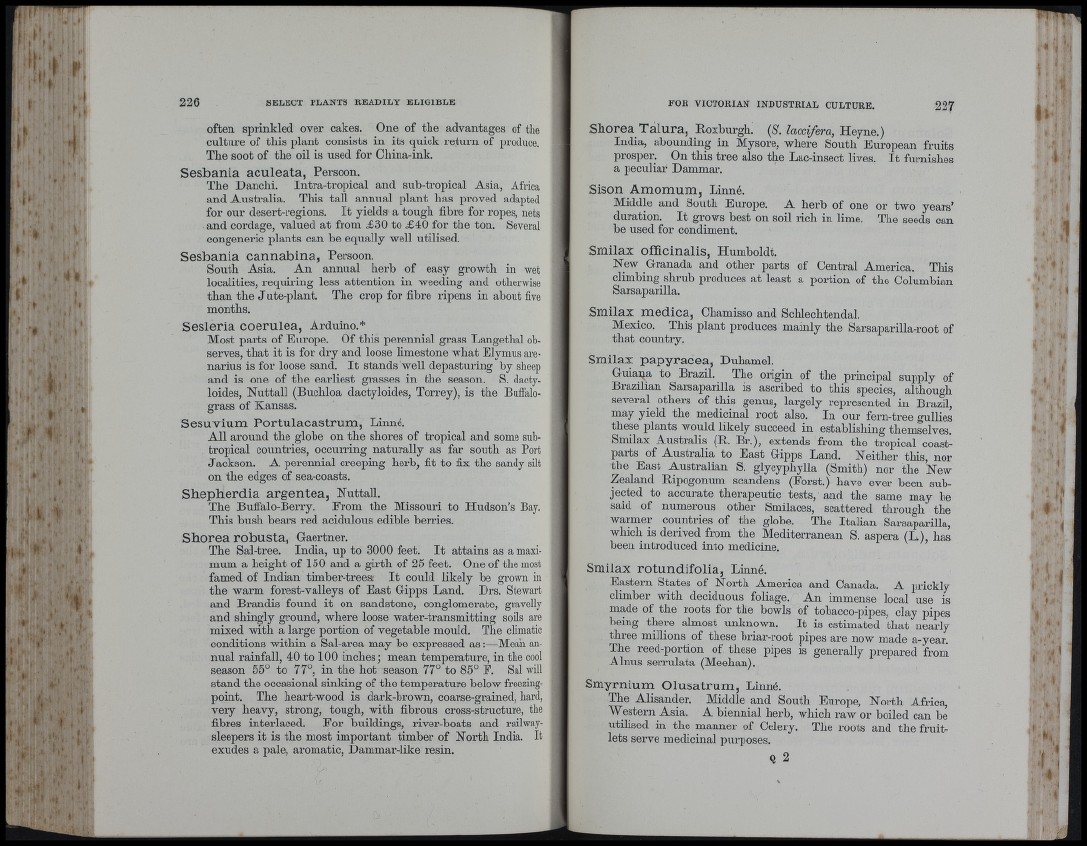
often spi’inkled over cakes. One of the advantages of the
culture of this plant consists in its quick return of produce.
The soot of the oil is used for China-ink.
Sesbania aculeata, Persoon.
The Danchi. Intra-tropical and sub-tropical Asia, Africa
and Australia. This tall annual plant has proved adapted
for our desert-regions. I t yields a tough fibre for ropes, nets
and cordage, valued a t from £30 to £40 for the ton. Several
congeneric plants can be equally well utilised.
Sesbania cannabina, Persoon.
South Asia. An annual herb of easy growth in wet
localities, requiring less attention in weeding and otherwise
than the J ute-plant. The crop for fibre ripens in about five
months.
Sesleria coerulea, Arduino.*
Most parts of Europe. Of this perennial grass Langethal observes,
th a t it is for dry and loose limestone what Elymus are-
narius is for loose sand. I t stands 'well depasturing by sheep
and is one of tbe earliest grasses in tbe season. S. dactyloides,
Nuttall (Bucliloa dactyloides, Torrey), is the Buffalo-
grass of Kansas.
Sesuvium Portulacastrum, Linné.
All around the globe on the shores of tropical and some subtropical
countries, occurring naturally as far south as Port
Jackson. A. perennial creeping herb, fit to fix the sandy silt
on the edges of sea-coasts.
Shepherdia argentea, Nuttall.
The Bufialo-Berry. Erom the Missouri to Hudson’s Bay.
This bush bears red acidulous edible berries.
Shorea robusta, Gaertner.
The Sal-tree. India, up to 3000 feet. I t attains as a maximum
a height of 150 and a girth of 25 feet. One of the most
famed of Indian timber-trees? I t could likely be grown in
tbe warm forest-valleys of East Gipps Land. Drs. Stewart
and Brandis found it on sandstone, conglomerate, gravelly
and shingly ground, where loose water-transmitting soils are
mixed with a large portion of vegetable mould. The climatic
conditions within a Sal-area may be expressed as :—Meaii annual
rainfall, 40 to 100 inches; mean temperature, in the cool
season 55° to 77°, in the hot season 77° to 85° F. Sal will
stand the occasional sinking of the temperature below freezing-
point. The heart-wood is dark-brown, coarse-grained, hard,
very heavy, strong, tough, with fibrous cross-structure, the
fibres interlaced. Eor buildings, river-boats and railway-
sleepers it is the most important timber of North India. It
exudes a pale, aromatic, Dammar-like resin.
Shorea Talura, Roxburgh. (S. laccifera, Heyne.)
India, abounding in Mysore, where South European fruits
prosper. On this tree also the Lac-insect lives. I t furnishes
a peculiar Dammar.
Sison Amomum, Linné.
Middle and South Europe. A herb of one or two years’
duration. I t grows best on soil rich in lime. The seeds can
be used for condiment.
Smilax officinalis, Humboldt.
New Granada and other parts of Central America. This
climbing shrub produces at least a portion of tbe Columbian
Sarsaparilla.
Smilax medica, Chamisso and Scblecbtendal.
Mexico. This plant produces mainly the Sarsaparilla-root of
that country.
Smilax papyracea, Duhamel.
Guiapa to Brazil. _ The origin of the principal supply of
Brazilian Sarsaparilla is ascribed to tbis species, although
several others of this genus, largely represented in Brazil,
may yield the medicinal root also. In our fern-tree gullies
these plants would likely succeed in establishing themselves.
Smilax Australis (R. Br.), extends from the tropical coast-
parts of Australia to East Gipps Land. Neither this, nor
the East Australian S. glycyphylla (Smith) nor the New
Zealand Ripogonum scandens (Forst.) have ever been subjected
to accurate therapeutic tests, and the same may be
said of numerous other Smilaces, scattered through the
warmer countries of the globe. Tbe Italian Sarsaparilla,
wliicb IS derived from the Mediterranean S. aspera (L.), has
been introduced into medicine.
Smilax rotundifolia, Linné.
Eastern States of North America and Canada. A prickly
climber with deciduous foliage. An immense local use is
made of the roots for the bowls of tobacco-pipes, clay pipes
being there almost unknown. I t is estimated that nearly
three millions of these briar-root pipes are now made a-year.
The reed-portion of these pipes is generally prepared from
Alnus serrulata (Meehan).
Smyrnium Olusatrum, Linné.
The Alisander. Middle and South Europe, North Africa,
Western Asia. A biennial herb, which raw or boiled can be
utilised in the manner of Celery. The roots and the fruit-
lets serve medicinal purposes.
Q 2